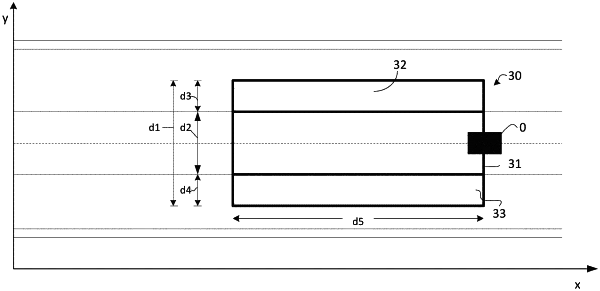| CPC B60W 30/143 (2013.01) [B60W 30/16 (2013.01); B60W 40/04 (2013.01); B60W 60/001 (2020.02); B60W 2520/105 (2013.01); B60W 2554/4041 (2020.02); B60W 2554/801 (2020.02); B60W 2720/106 (2013.01)] | 20 Claims |

|
1. A computer-implemented method comprising:
determining, based on a detected position of a leading vehicle relative to a host vehicle, a lateral position of a model of the leading vehicle in a model of a road on which the leading vehicle and the host vehicle are traveling, the road comprising a plurality of lanes;
defining a lateral range extending from the model of the leading vehicle in the model of the road, the lateral range extending in a first lateral direction in the model of the road and a second lateral direction in the model of the road that is opposite to the first lateral direction,
the lateral range comprising a first lateral subrange, a second lateral subrange, and a central lateral subrange between the first lateral subrange and the second lateral subrange,
the lateral range defined to increase based on an increase of at least one of the first lateral subrange and the second lateral subrange with increasing distance between the determined lateral position of the model of the leading vehicle and a lateral position in the model of the road of a center of a lane among the plurality of lanes in which the model of the leading vehicle is located during a lane change by the model of the leading vehicle from the lane to an adjacent lane of the plurality of lanes;
setting a longitudinal range extending from a rear of the model of the leading vehicle in a first longitudinal direction in the model of the road, the longitudinal range being set to a predetermined value;
setting a target longitudinal acceleration of the host vehicle such that, for a longitudinal position of the model of the host vehicle that is within the longitudinal range, the target longitudinal acceleration of the host vehicle is set to:
a respective first longitudinal acceleration value when a lateral position of the model of the host vehicle in the model of the road is within the central lateral subrange; and
a respective second longitudinal acceleration value when the lateral position of the model of the host vehicle is within the first lateral subrange or the second lateral subrange, the respective second longitudinal acceleration value being greater than the first longitudinal acceleration value and dependent on the lateral position of the model of the host vehicle in the model of the road relative to the determined lateral position of the model of the leading vehicle; and
autonomously controlling a speed of the vehicle using the set target longitudinal acceleration.
|